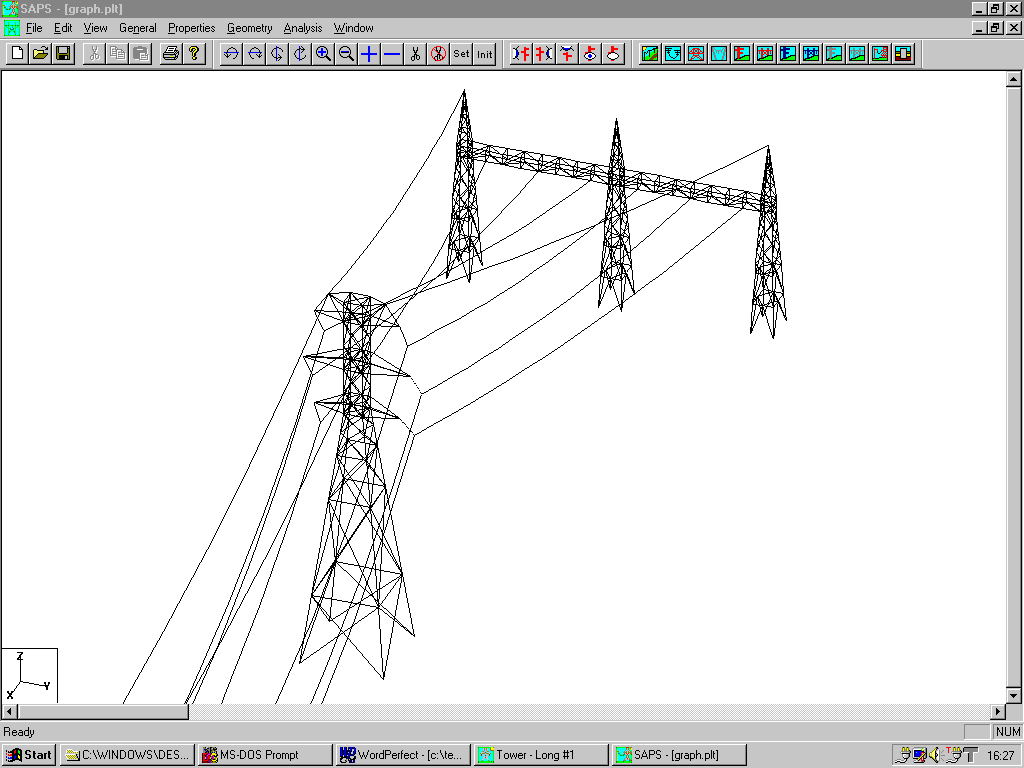

True 3-dimensional finite element editing, modeling, analyzing and displaying of transmission lines and their structures has been available with our SAPS program since 1985. With SAPS, all conductors and ground wires are modeled as true 3-d cable elements with stiffness and end forces depending on the wind magnitude and direction, ice thickness and temperature.
3-d finite element modeling is the only accurate way to analyze the interaction between structures and cables under complex loadings such as unbalanced ice, broken conductors, slack changes, unequal tensions at different temperatures, skewed wind, etc. The 3-d modeling considers not only the transverse but also the longitudinal swings of all insulators. It also considers the lateral and longitudinal displacements of the structure attachment points when making clearance calculations. This is important when checking pole lines under lateral wind. The Figure shows a line portion modeled with SAPS near its termination at a sub-station structure under both calm and wind conditions. All cables are displayed in 3-d, clearances can be checked visually or by reference to the printed coordinates of points along the cables. Note that the insulator swings vary by phase due to the small induced line angles between the suspension tower and the gantry. The structures themselves can be analyzed for deflections, axial forces and moments.
In our 3-d modeling, the structures, insulators and cables are physical models which allow detailed engineering calculations (strengths and clearances). This is quite different from drawing simplistic models in a CAD system, where the structure, insulator and cable geometries are often drawing cells incapable of interacting with each other.
Because 3-d finite element modeling may be onerous both in term of model preparation and computer time, approximations are often necessary.
The first level of approximation consists of modeling only one phase at a time, and not the complete system. The phase is modeled between dead ends (one tension section). All insulator attachment points for the tension section are fixed locations in a 3-d coordinate system but the entire conductor or ground wire in the section is still modeled by a true 3-d finite element model. The structural flexibility of the attachment points is accounted for by equivalent springs. This reduced modeling can be several orders of magnitude more efficient than the full modeling. It is implemented in our multi-span sags and tensions program SAGSEC. SAGSEC allows you to make calculations of sags, tensions and structure loads when the ruling span concept is not acceptable or the loads are not identical on all the spans.
The second and less accurate level of approximation is to still model the insulator attachment points at fixed structure locations in 3-d and to assume that the horizontal component of cable tension is constant over the entire length of each tension section. This "ruling span" assumption has its limitations as demonstrated in the SAGSEC manual. However, because of its simplicity, the ruling span assumption is used in most line design programs such as our PLS-CADD product. Unlike most other line design programs, PLS-CADD has the option to link directly to SAGSEC and SAPS to escape the "ruling span" assumption and produce more accurate tensions, sags and loads at the click of the mouse.
| Structural Analysis of Power and communication Systems |
|
| Sags and tensions in multi span systems |

